In recent years, the line between the physical and digital worlds has been blurring. Two technologies at the forefront of this evolution are Virtual Reality and Digital Twin. While they serve different purposes, their impact on modern industries is significant.
- Defining Virtual Reality (VR)
- Exploring Digital Twin (DT)
- Technological Foundations for Virtual Reality and Digital Twin Applications
- Interaction Paradigms for VR and DT
- Application Domains of Virtual Reality and Digital Twin
- VR in Gaming and Entertainment
- Comparative Table of Application Domains
- Benefits and Challenges of Virtual Reality and Digital Twin Technologies
- Advantages of VR and DT
- Overcoming Hurdles
- Comparative Table of VR and DT Benefits and Challenges
- Top 10 Future Trends of Virtual Reality and Digital Twin in 2025
- 1) Generative AI:
- 2) Multi-Sensory Technology:
- 3) Mixed Reality – AR and VR Convergence:
- 4) Immersive Training and Education:
- 5) Immersive Retail and Customer Experience:
- 6) Collaborative Working:
- 7) More Powerful, Versatile, or Lighter Devices:
- 8) Haptic Technology:
- 9) Virtual Simulations:
- 10) Metaverse Realization:
- Final Words
- FAQs
Defining Virtual Reality (VR)
Virtual Reality (VR) is a technology that allows users to interact with a computer-generated environment. It creates an immersive, 3-dimensional space that can be similar to or completely different from the real world. Through sophisticated hardware and software, users can explore and interact within these simulated environments in a way that feels incredibly real, bridging the gap between the digital and the physical.
VR has the power to transport individuals to different realms, making it a potent tool for various applications like education, training, best gaming apps, and therapeutic practices. By stimulating our senses in a coherent manner, VR provides a unique experience that can be both entertaining and educational.
Top Virtual Reality Headsets for Schools & VR Educational Apps
Exploring Digital Twin (DT)
On the other hand, a Digital Twin (DT) is a digital replica of a physical object or system. It allows for real-time monitoring and analysis, aiding in better decision-making and predictive maintenance. By creating a dynamic model, DT provides a clear insight into the performance, workings, and potential issues of the physical counterpart, making it a crucial tool for modern-day industrial and urban planning scenarios.
Through its real-time feedback loop, stakeholders can foresee problems, optimize operations, and achieve better outcomes.
Trending: Google’s New AR Feature: Try Makeup Before You Buy!
Technological Foundations for Virtual Reality and Digital Twin Applications
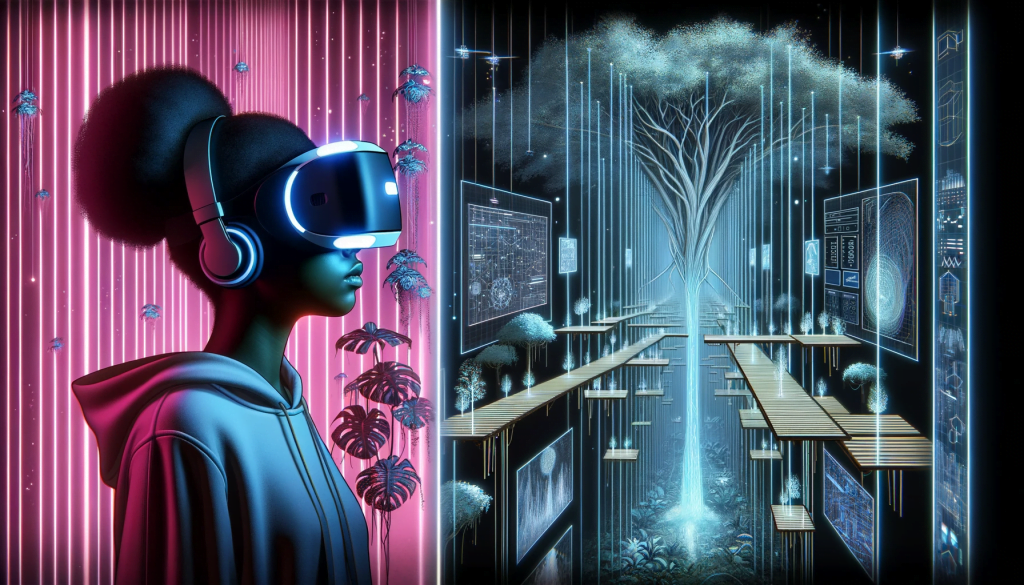
Understanding the technological underpinnings is crucial to grasp the full spectrum of Virtual Reality and Digital Twin applications. The hardware and software requirements, though distinct, lay the groundwork for the immersive and analytical capabilities of VR and DT respectively.
Hardware Requirements
The hardware is the bedrock upon which the virtual and digital realms are built. Here’s a comparative look at the hardware essentials for both VR and DT:
Hardware Requirements For Virtual Reality:
- Visualization: VR primarily requires headsets that are capable of rendering 3D environments to the user.
- Interaction: Input devices like gloves or handheld controllers enable users to interact with the virtual environment.
- Sensing: Sensors like motion trackers and eye-tracking devices enhance the interactive experience by capturing the user’s movements and gaze.
- Processing: High-performance computers or consoles are necessary to process and render complex VR environments in real-time.
- Connectivity: Wired or wireless connections ensure seamless interaction and a lag-free experience.
Hardware Requirements For Digital Twin:
- Visualization: Monitors and projectors are used to display the digital twin models and analytics.
- Interaction: Standard input devices like a mouse and keyboard are used to interact with the digital twin interface.
- Sensing: Various sensors collect real-time data from the physical object or system being mirrored.
- Processing: Servers or cloud computing platforms analyze and process the collected data.
- Connectivity: Industrial Internet of Things (IIoT) devices ensure continuous data flow between the physical and digital realms.
| Hardware Component | Virtual Reality | Digital Twin |
|---|---|---|
| Visualization | VR Headsets like Oculus Rift, HTC Vive | Monitors, Projectors |
| Interaction | Handheld Controllers, Haptic Gloves | Mouse, Keyboard |
| Sensing | Motion Sensors, Eye Tracking | Various Sensors (e.g., Temperature, Pressure) |
| Processing | High-Performance PCs or Consoles | Servers, Cloud Computing |
| Connectivity | Wired/Wireless Connections | Industrial Internet of Things (IIoT) Devices |
Do you know? Cloud Computing vs Artificial Intelligence
Software Platforms for Virtual Reality and Digital Twin
The software platforms for Virtual Reality and Digital Twin are as varied as their applications. They serve as the bridge between the hardware and the user, allowing for the creation, management, and interaction with virtual and digital environments.
Software Platforms For Virtual Reality:
- Development Environments: Software like Unity and Unreal Engine are popular for creating interactive 3D content.
- Rendering Engines: These engines are crucial for generating realistic visuals, physics, and interactions.
- Middleware: Middleware software handles tasks like input, network communications, and much more, ensuring a cohesive VR experience.
Software Platforms For Digital Twin:
- Modeling Software: Tools like Siemens PLM and Dassault Systemes enable the creation of precise digital twin models.
- Analytics Platforms: These platforms process and analyze the data collected from sensors, providing actionable insights.
- Integration Middleware: Middleware ensures seamless communication between the digital twin, the physical object or system, and other enterprise systems, facilitating real-time monitoring and analysis.
| Software Component | Virtual Reality | Digital Twin |
|---|---|---|
| Development Environments | Unity, Unreal Engine | Siemens PLM, Dassault Systemes |
| Rendering Engines | Unreal Engine, CryEngine | NA |
| Middleware | Various Middleware Platforms | Various Middleware Platforms |
| Analytics Platforms | NA | Predix, ThingWorx |
| Integration Middleware | NA | Various Middleware Platforms |
The robust technological foundations of VR and DT not only differentiate them but also hint at their complementary potential. As these technologies continue to evolve, we might witness a fusion, unlocking new vistas of possibilities in the digital landscape.
Also Read: React Native VS Swift: Which one to choose for Your Next Project?
Interaction Paradigms for VR and DT
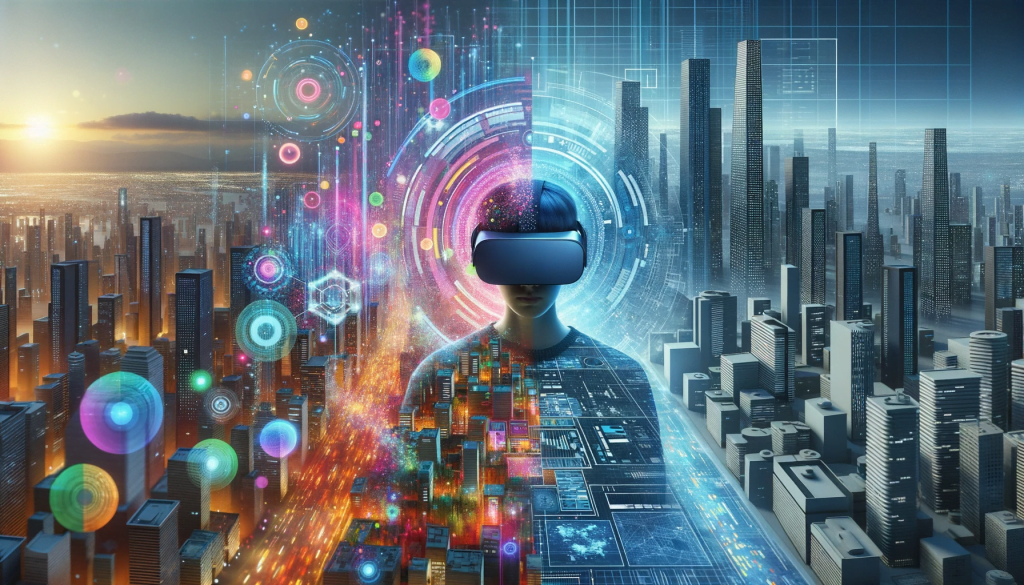
The interaction paradigms of Virtual Reality and Digital Twin represent two sides of a spectrum: one offers a dive into a fully fabricated digital world, while the other extends and mirrors the physical world in a digital format. Understanding these paradigms is critical for appreciating the potential and limitations of these technologies.
Also check the list of Top Virtual Reality (VR) Game Development Companies
Immersive Experience in VR
Virtual Reality (VR) thrives on creating an immersive experience. Once the user dons a VR headset, they are transported to a computer-generated world. Unlike traditional interfaces, VR engages multiple senses including vision, hearing, and even touch in some advanced setups.
The key components of interaction in VR include:
- Visualization: Creating a convincing visual representation of a digital environment.
- Navigation: Enabling users to move around and explore the digital space.
- Manipulation: Allowing users to interact with digital objects as they would in the real world.
- Communication: Facilitating interaction between users within the VR environment.
These components work together to create a holistic digital experience that can be both engaging and intuitive.
Data Interaction in DT
In the realm of Digital Twin (DT), interaction is more about engaging with data and digital replicas of physical entities. Unlike VR, DT doesn’t usually offer a fully immersive sensory experience. Instead, it provides a platform for analyzing, monitoring, and manipulating digital replicas.
The core aspects of DT interaction include:
- Data Collection: Gathering real-time data from the physical world.
- Visualization: Representing the digital twin and its data in a meaningful way.
- Analysis: Understanding the implications of the data and making informed decisions.
- Manipulation: Making changes to the digital twin and observing the potential impact on the physical counterpart.
These facets enable a deep understanding and control over physical systems from a digital vantage point.
Comparison Table Interaction Paradigms for Virtual Reality (VR) and Digital Twin (DT)
| Feature | Virtual Reality (VR) | Digital Twin (DT) |
|---|---|---|
| Primary Goal | Immersive Experience | Data Interaction |
| Visualization | 3D Graphics, Immersive Displays | 2D/3D Graphics, Analytic Dashboards |
| User Interaction | Navigation, Manipulation, Communication | Data Analysis, Manipulation |
| Hardware | VR Headset, Controllers | Sensors, Data Processing Systems |
| Real-world Integration | Limited | Extensive |
| Typical Applications | Gaming, Training, Simulation | Industrial Monitoring, Urban Planning |
This table succinctly encapsulates the contrasting paradigms of interaction in VR and DT, portraying how they are tailored to suit their respective objectives while harnessing the power of digital technology to enhance or replicate real-world experiences and operations.
Also Read: How Virtual Reality (VR) in Education is Changing Edtech Industry?
Application Domains of Virtual Reality and Digital Twin
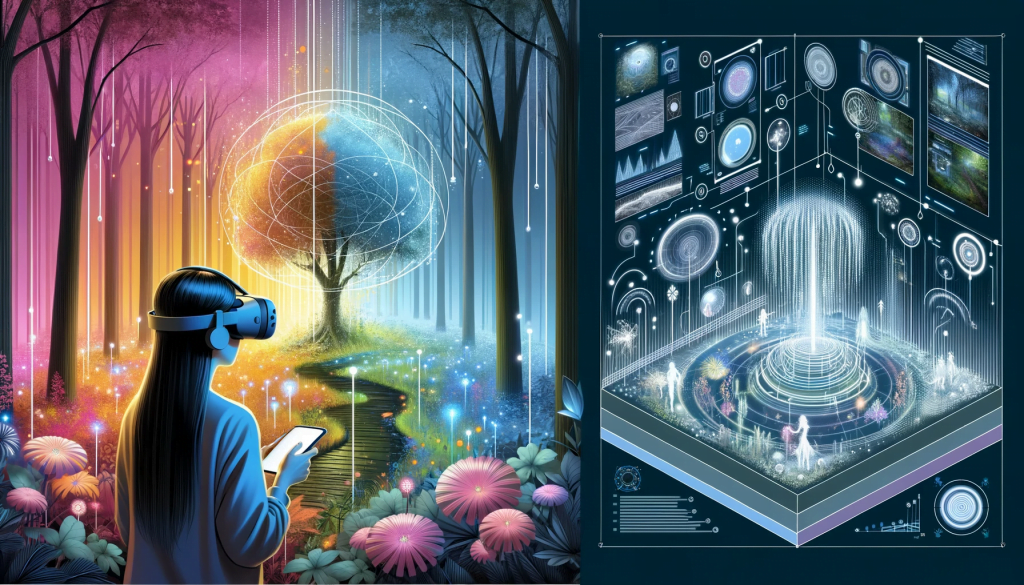
The application domains of Virtual Reality and Digital Twin are vast and varied, each catering to different sectors and solving unique problems. While Virtual Reality predominantly serves in gaming, entertainment, and education, Digital Twin finds its footing in the industrial, urban planning, and healthcare sectors. Let’s delve deeper into these domains.
VR in Gaming and Entertainment
Virtual Reality has significantly impacted the gaming and entertainment industries, offering an immersive experience that traditional mediums can’t match. In gaming, VR transports players into realistic, 3-dimensional game environments where they can interact with the game elements in a natural, intuitive way. It’s not just about playing a game; it’s about living in it.
Similarly, in the entertainment sector, VR can transport audiences into the film or show’s universe, creating a more engaging viewing experience. Theme parks have also adopted VR to enhance rides and attractions, providing guests with unforgettable, immersive experiences.
DT in Industrial and Urban Planning
Digital Twin technology is a game-changer in industrial settings and urban planning. In industries, DT helps in creating a digital replica of machinery or processes which aids in real-time monitoring, predictive maintenance, and analyzing system performance under different conditions. This real-time feedback loop allows for better decision-making and operational efficiency.
In urban planning, DT can provide a digital model of urban areas, helping planners visualize the implications of their designs in real-time. It aids in better planning, reduces costs, and helps in managing and monitoring urban infrastructure effectively.
Comparative Table of Application Domains
| Application Domain | Virtual Reality (VR) | Digital Twin (DT) |
|---|---|---|
| Gaming | High | Low |
| Entertainment | High | Low |
| Education | Moderate | Moderate |
| Industrial | Low | High |
| Urban Planning | Low | High |
| Healthcare | Moderate | High |
| Real Estate | Moderate | Moderate |
This table encapsulates a simplified view of how VR and DT are poised in various application domains. It’s evident that while both technologies have their merits, their applications are tailored towards different sectors. The blend of Virtual Reality and Digital Twin is a glimpse into the future, where digital augmentation can serve multiple facets of our lives, making processes simpler, experiences richer, and decisions better.
Do you Know? The Rise of VR in Los Angeles
Benefits and Challenges of Virtual Reality and Digital Twin Technologies
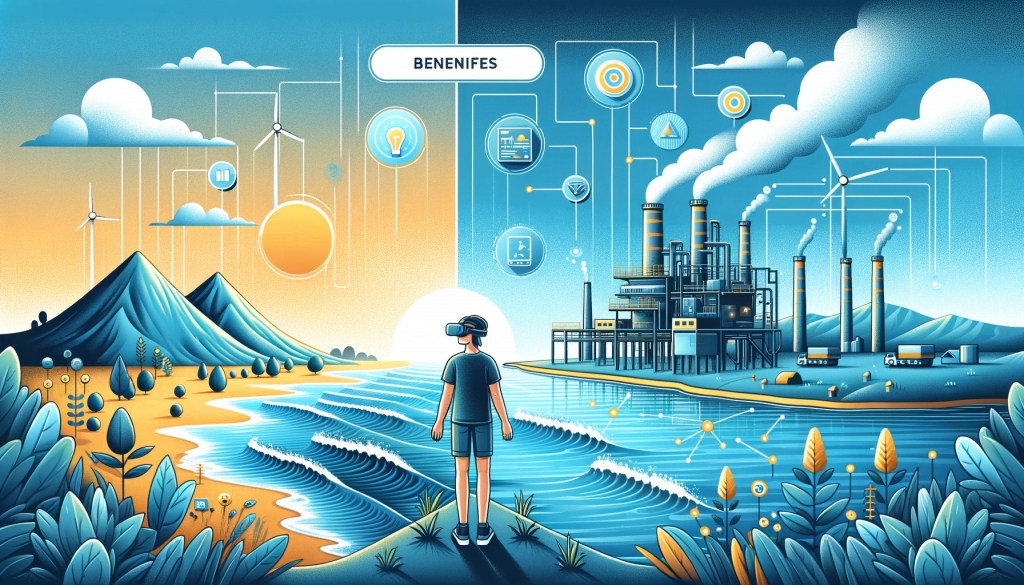
The adoption and integration of Virtual Reality and Digital Twin technologies come with an array of benefits but also present some challenges that need to be navigated. Both technologies herald a new age of interaction and understanding of digital and physical environments. However, the road to widespread adoption and maximum utility is not devoid of hurdles. Below we delve into the merits and demerits associated with these innovative technologies.
Advantages of VR and DT
- Enhanced Interaction and Understanding:
- VR provides an immersive environment where individuals can interact with digital content in a more natural and intuitive manner. This enhances understanding and retention.
- DT facilitates a deep understanding of physical systems by mirroring them in a digital space, allowing for real-time monitoring and analysis.
- Improved Decision-making:
- The immersive nature of VR can aid in better decision-making by providing a realistic representation of scenarios.
- DT provides actionable insights derived from real-time and historical data, aiding in informed decision-making.
- Cost Efficiency:
- VR can potentially save costs in training and development by creating realistic simulation environments.
- DT can lead to cost savings through predictive maintenance and optimization of operations.
- Innovation and Product Development:
- VR can accelerate product design and development through rapid prototyping in a virtual environment.
- DT enables a continuous feedback loop between the physical and digital representation, fostering innovation and improvement.
- Safety and Training:
- VR provides a safe environment for training, especially in high-risk industries like healthcare and aviation.
- DT can predict potential system failures, enhancing safety measures.
Overcoming Hurdles
- High Initial Costs:
- The initial investment required for hardware and software can be a deterrent for small to medium enterprises.
- Technical Complexities:
- Both VR and DT require a certain level of technical expertise for implementation and operation, which can be a barrier for many organizations.
- Data Privacy and Security:
- The collection and analysis of data, especially in DT, raise concerns regarding data privacy and security.
- Integration with Existing Systems:
- Integrating VR and DT technologies with existing systems and processes can be challenging and may require additional resources and expertise.
Comparative Table of VR and DT Benefits and Challenges
| Aspect | Virtual Reality (VR) | Digital Twin (DT) |
|---|---|---|
| Enhanced Interaction | Provides immersive, intuitive interactions | Mirrors physical systems for real-time analysis |
| Decision-making | Realistic scenario representation aids decisions | Actionable insights from real-time & historical data |
| Cost Efficiency | Potential savings in training and development | Predictive maintenance & operation optimization |
| Innovation | Accelerates product design & development | Continuous feedback fosters innovation |
| Safety and Training | Safe environment for high-risk industry training | Predictive analysis enhances safety measures |
| Initial Costs | High cost for hardware and software | High initial investment for implementation |
| Technical Complexities | Requires technical expertise for operation | Requires technical expertise for implementation |
| Data Privacy | May collect user interaction data | Significant data collection, privacy concerns |
| Integration | Challenge in integrating with existing systems | Challenge in integrating with existing systems |
This section aims to provide a well-rounded understanding of the merits and hurdles associated with Virtual Reality and Digital Twin technologies, laying the groundwork for informed discussions and decisions regarding their adoption and integration.
Also Read: Best Augmented Reality Development Companies
Top 10 Future Trends of Virtual Reality and Digital Twin in 2025
As we move further into the digital age, Virtual Reality and Digital Twin technologies keep growing and changing. Here’s a simple look into the top 10 trends that are set to shape these exciting technologies in the year 2025.
1) Generative AI:
Generative AI technologies are expected to contribute significantly to creating immersive and engaging online experiences. These technologies will facilitate the production of digital worlds, including their environments, artwork, and characters, which is essential for both VR and DT applications. The use of Generative AI can also accelerate the design process for 3D environments and populate these digital worlds with realistic characters for enhanced user engagement.
2) Multi-Sensory Technology:
The introduction and development of multi-sensory technologies, like haptic gloves and full-body suits, will provide users with a more immersive experience by allowing them to feel weight, pressure, and potentially even scents within the virtual or digital environment. This level of immersion is crucial for a variety of applications within VR, and could also find relevance in DT scenarios where a realistic representation of physical objects and environments is required.
3) Mixed Reality – AR and VR Convergence:
The convergence of Augmented Reality (AR) and VR is anticipated to create blended mixed-reality environments. For instance, during live events, a digital twin could run in parallel as a virtual event, allowing virtual and in-person attendees to interact with each other. This trend reflects a growing integration between the physical and digital worlds, a core aspect of DT, and enhanced immersive experiences, a hallmark of VR.
4) Immersive Training and Education:
VR and AR technologies are expected to continue gaining traction in training and educational domains. Immersive virtual learning environments and training programs enable learners to absorb knowledge more efficiently and apply their skills with greater confidence. The growth in platforms allowing even smaller organizations to leverage these immersive technologies for training and education is anticipated to continue.
5) Immersive Retail and Customer Experience:
Retail brands are expected to utilize AR and VR technologies for creating more immersive customer experiences. Whether it’s virtually trying on clothes or exploring how furniture would look in a personal space, these immersive technologies are set to refine and enhance the retail experience. Furthermore, the immersive customer journey from marketing to after-sales service is expected to be enriched through VR and AR, aiding brands in building stronger relationships with their customers.
6) Collaborative Working:
The enhancement of online platforms for collaborative work through VR and AR technologies is anticipated. These immersive technologies will help in capturing and expressing subtle aspects of interaction which are hard to replicate in standard video calls, thus improving remote and distributed working experiences.
7) More Powerful, Versatile, or Lighter Devices:
The evolution of hardware, including the release of more powerful or lighter devices like AR glasses and VR headsets, will continue to be a significant trend. These advancements in hardware are essential for broadening the adoption and enhancing the user experience of VR and DT technologies.
8) Haptic Technology:
Haptic technology, which provides a sense of touch in virtual environments, is expected to significantly disrupt the entertainment industry and potentially other industries as well.
9) Virtual Simulations:
The use of virtual simulations using extended reality (XR) and DT technologies for more efficient design, development, and safe testing of product prototypes and manufacturing processes is expected to be a trend in 2025.
10) Metaverse Realization:
The concept of the metaverse, a virtual shared space where users can interact with each other and digital environments, is expected to see significant strides toward its realization in 2025.
These trends illustrate a blend of technological advancements, enhanced user experiences, and broader application domains for both Virtual Reality and Digital Twin technologies.
Final Words
The journey of Virtual Reality and Digital Twin technologies is a testament to human ingenuity. As we continue to bridge the digital and physical realms, the possibilities are endless, and the impact on our daily lives and the global economy is profound.
FAQs
Virtual Reality creates immersive digital environments, while Digital Twin creates digital replicas of physical objects or systems.
VR is prominent in gaming and entertainment, while DT is utilized in industrial settings and urban planning.
VR requires headsets and input devices, whereas DT requires sensors and analytic platforms.
The convergence of VR and DT opens up possibilities for enhanced simulation, analysis, and interaction between physical and digital worlds.
Case studies like VR in Oculus Rift and DT in Siemens’ Digital Twin solutions showcase the diverse applications and benefits of these technologies.




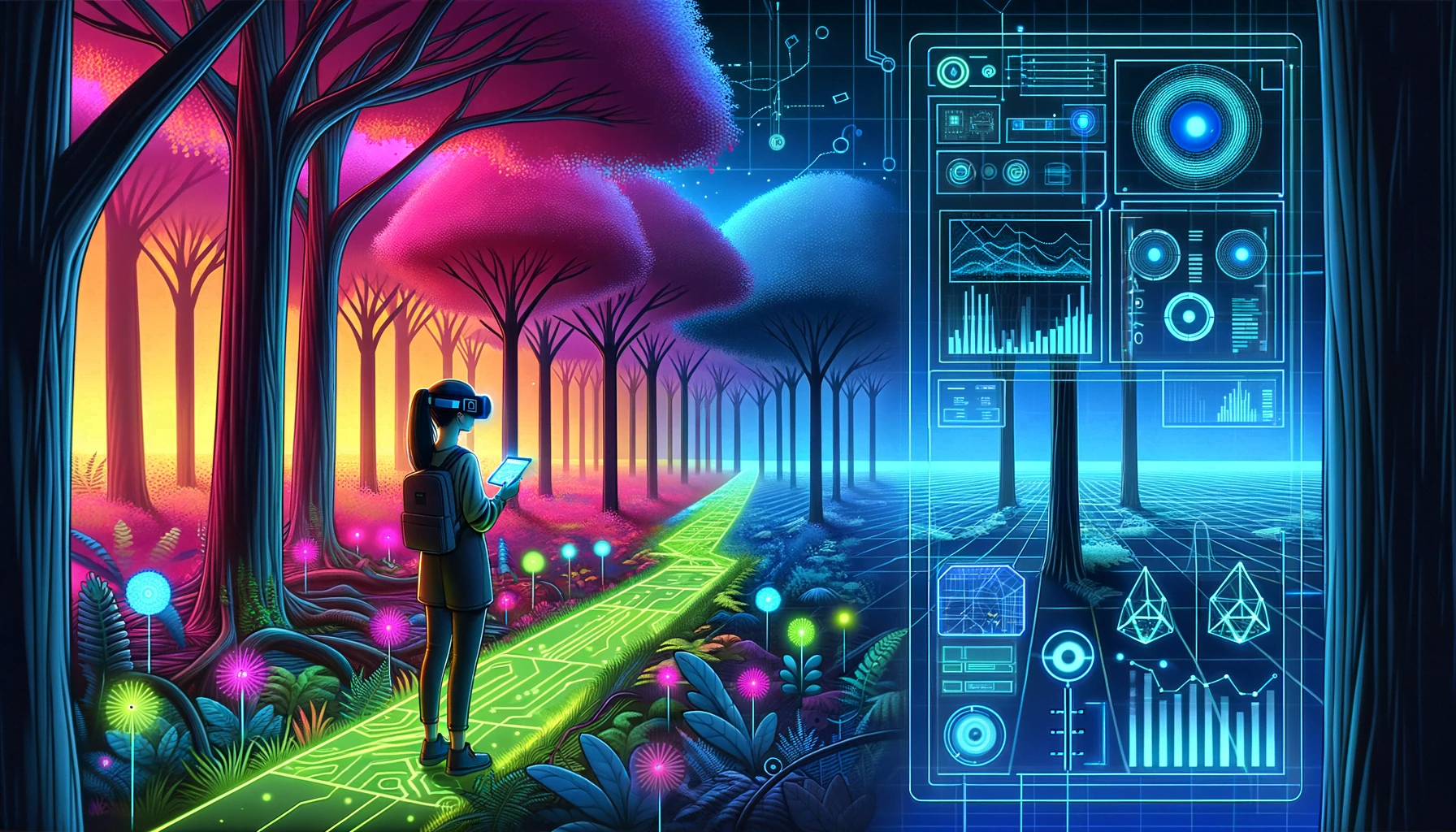





Leave a Reply